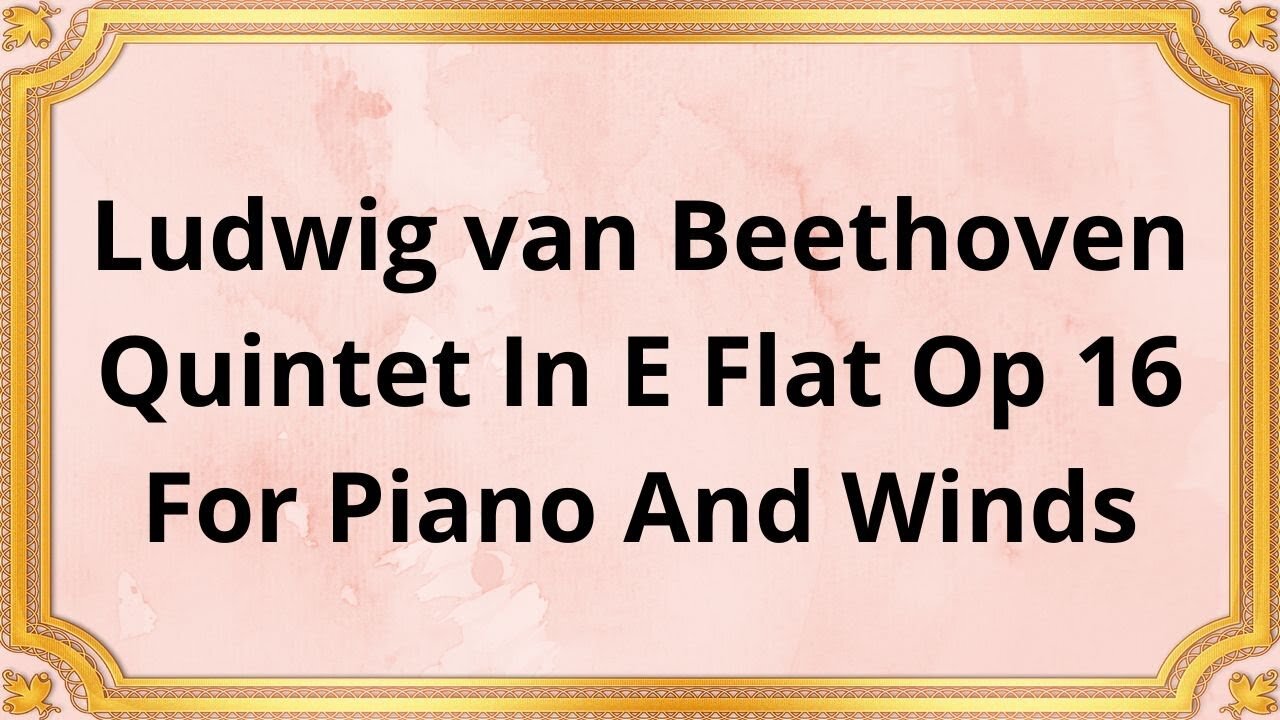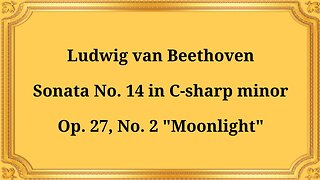Premium Only Content

Ludwig van Beethoven Quintet In E Flat Op 16, For Piano And Winds
#Beethoven #ClassicalMusic #QuintetInEFlat #Op16 #PianoAndWinds #ChamberMusic #RomanticEra #ClassicalComposers #MusicTheory #MusicAppreciation #MusicEducation #MusicPerformance #MusicEnsemble #PianoMusic #WoodwindMusic
Ludwig van Beethoven, a legendary figure in classical music, left an indelible mark on the world of composition. Among his vast repertoire, the Quintet in E-flat, Op. 16, for Piano and Winds, stands as a remarkable example of his brilliance and innovation.
Composed in the late 18th century during the Classical period, Beethoven's Quintet in E-flat, Op. 16, embraces the elegance and refinement of the time. It was written in 1796, a period when Beethoven was transitioning from his early Classical style to his more adventurous and expressive compositions. This quintet is a testament to his mastery of chamber music and his ability to push the boundaries of traditional forms.
The Quintet in E-flat, Op. 16, comprises four movements, each showcasing a unique blend of piano and wind instruments. The instrumentation consists of a piano, oboe, clarinet, horn, and bassoon. This combination allows for a diverse range of timbres, creating a rich and dynamic musical landscape. Beethoven's thoughtful interplay between the piano and winds highlights the distinct character and capabilities of each instrument.
Movement I: Allegro con brio:
The opening movement, Allegro con brio, sets the tone for the entire composition. It begins with a bold and energetic piano introduction, followed by the entrance of the winds, each instrument contributing to the melodic and harmonic development. Beethoven's mastery is evident as he seamlessly weaves together contrasting themes, showcasing his ability to balance power and delicacy.
Movement II: Andante cantabile:
The second movement, Andante cantabile, offers a contrasting mood, imbued with lyrical beauty and introspection. Here, the winds take center stage, with the piano providing a supportive and delicate accompaniment. Beethoven's melodic lines evoke a sense of longing and tenderness, captivating the listener with their emotional depth.
Movement III: Rondo: Allegro ma non troppo:
The third movement, Rondo: Allegro ma non troppo, brings a lively and spirited character to the composition. It showcases Beethoven's playful and witty side, with the piano and winds engaging in a vibrant dialogue. The contrasting sections of the rondo form add excitement and unpredictability, keeping the listener engaged until the exhilarating finale.
Movement IV: Polonaise: Andante:
The final movement, Polonaise: Andante, pays homage to the Polish dance form, characterized by its stately and regal nature. Beethoven infuses the movement with elegance and grace, intertwining the piano and winds in a majestic dance. The resounding conclusion leaves a lasting impression, showcasing Beethoven's ability to create a sense of grandeur within the chamber music setting.
Beethoven's Quintet in E-flat, Op. 16, for Piano and Winds, holds a significant place in the classical music repertoire. It stands as a testament to his innovative approach to composition and his ability to showcase the unique qualities of each instrument. This quintet paved the way for future composers to explore the possibilities of combining piano and winds, leaving a lasting legacy in the world of chamber music.
Conclusion:
Beethoven's Quintet in E-flat, Op. 16, is a shining example of his genius and musical prowess. Through its refined structure, captivating instrumentation, and emotionally charged movements, this composition continues to enchant audiences and captivate performers. As we immerse ourselves in the harmonious fusion of piano and winds, we gain a deeper appreciation for Beethoven's ability to create timeless and inspiring musical masterpieces.
You have the opportunity to support the channel:
https://destream.net/live/RadSiarAl/donate
https://www.buymeacoffee.com/6355radsiaral
-
 18:26
18:26
Classical music_Music Inspiration
1 month agoLudwig van Beethoven Sonata No. 14 in C-sharp minor, Op. 27, No. 2 "Moonlight"
821 -
 3:05:42
3:05:42
Barry Cunningham
6 hours agoPRESIDENT TRUMP DESTROYS GAVIN NEWSOM'S PARTY! (AND MORE NEWS)
70.4K40 -
 LIVE
LIVE
SpartakusLIVE
8 hours ago#1 WZ Hero can’t stop WINNING || BF6 Later?!
226 watching -
 9:18:15
9:18:15
ZWOGs
10 hours ago🔴LIVE IN 1440p! - Battlefield 6, Games w/ Maam, Kingdom Come Deliverance, & More - Come Hang Out!
33K2 -
 2:14:27
2:14:27
RiftTV
6 hours agoDHS TARGETS Online Right Wing Influencers For “ANTISEMITISM”? | The Rift | Guest: Simon Goddek
57.8K8 -
 2:40:12
2:40:12
megimu32
6 hours agoOTS: Rockin’ the Reels 🎸 Music Movies That Shaped Us
34.9K3 -
 9:47:12
9:47:12
Charlotte Winslow
11 hours ago🚗MARIO KART WORLD Online Battles & UNLOCKING THAT MIRROR MODE!
31.1K4 -
 13:46
13:46
MattMorseTV
8 hours ago $5.20 earned400% increase in PAID PROTESTERS.
53K36 -

HELMETFIRE
4 hours ago🟢BATTLEFIELD 6 - TIME TO LOCK IN!🟢
15.5K -
 3:37:03
3:37:03
MoFio23!
1 day agoParty Hard with SynthTrax: LIVE - Episode #1
10.1K